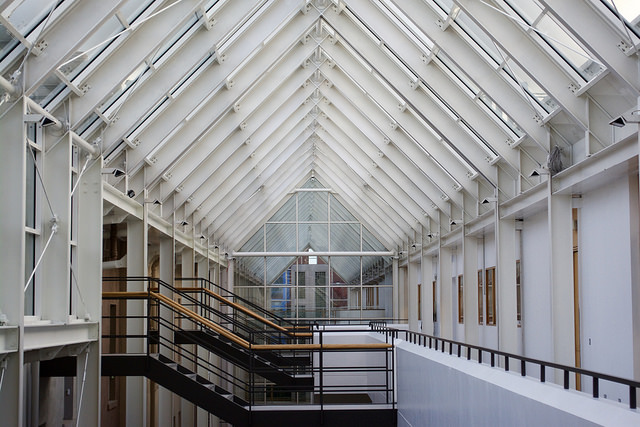The planned Engineering, Energy and Environment Institute (E3) Institute will now consist of two facilities, one off campus and one on campus, with plans for both not currently providing for the Simon Perry Building’s facilities.
In an interview with The University Times, Head of the School of Computer Science and Statistics, Prof Jeremy Jones, said that E3 will be split into two separate buildings and will not be a separate campus in the Grand Canal Dock area as has been suggested in the past.
When asked if either of the buildings will host the specialist civil engineering facilities currently housed in the Simon Perry Building, Jones said that they were “not currently included” in the plans for either the teaching building or research facility.
Jones said the plans for E3 have been split into two stages. The first stage will see an E3 teaching building being built on the site of the old biochemistry labs near the Lincoln Place entrance of campus: “What we are doing at the moment is very seriously planning the teaching building.”
The second stage of E3 will see the completion of an E3 research building. Jones added that the activities carried out at either E3 facility still need to be “defined”.
In an email statement to The University Times Trinity’s Bursar, Prof Veronica Campbell, said that “the infrastructure needs for E3 are currently being scoped but confirmed that “a potential site for a new teaching building is the former Biochemistry site on the East End of the campus”.
Campbell added that the research building will be incorporated into the existing Trinity Technology & Enterprise Campus (TTEC) on Pearse St: “The E3 project will also require research facilities and the development of the Trinity Technology & Enterprise Centre will factor in the needs of E3.”
Should the building go ahead on the TTEC on Pearse St, Jones did not rule out the possibility of “schools going down there in their entirety”.
Commenting on the delay in the demolition the Simon Perry Building, which was due to be demolished as part of the new Trinity Business School project, Jones said that, in his view, “the Perry Building has been given a temporary reprieve, so it not going to be knocked down straight away”.
However Campbell explained that “the requirements of the Simon Perry occupants will also be considered in E3 since the School of Engineering is an integral component of the E3 project”.
Speaking to The University Times, Director of Undergraduate Teaching and Learning for the school, Dr Mike Brady, said that the school will continue to work out of its current buildings, including the Lloyd Building and the O’Reilly Institute, and that the new buildings will add to these facilities.
“E3 will not be the only building that we have, we will still be here in [the O’Reilly Institute]. At least that is the plan at the moment”, explained Brady.
Jones said that the heads of the three schools that the buildings will incorporate – School of Computer Science and Statistics, School of Engineering and the School of Natural Sciences – have recently been invited to attend several meetings with the E3 committee: “There has been a real impetus about E3 from about September, so there has been a lot of real activity.”
The current aim is to have this completed by 2021, according to Jones. He commented that the committee is currently “trying to make sure it is financially viable” but that “ultimately we will probably need some support from government to help us” with the funding of the project.
Campbell added that “this planning exercise will continue over the coming months in order to develop a business case that can be considered by Board in due course”.
“It is getting very concrete, and I think the Provost is very keen to get this over the line”, Jones added.







